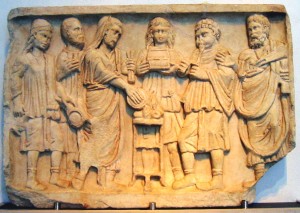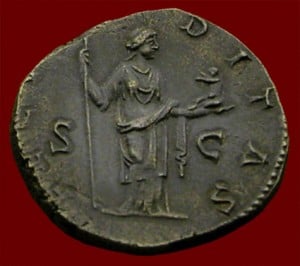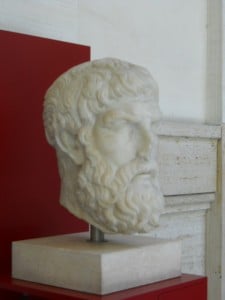The Roman caeremonium is composed of a number of stages, each stage composed of one or more rituals. The arrangement of these stages, and the order in which they may appear, can vary according to the kind of caeremonium. Here I follow a model posed by John North of University College London for the structure of Roman ritual, on which I have expanded some of the details.
I. – PRAEFATIO
The preliminary stage of a formal Roman ritual begins with a praeco (herald) calling for people’s attention by announcing “Hoc age!” The main celebrant then appoints his assistants, with the most important assistant being the minister sacrificii. An important feature in a Roman ceremony is the dialogue that takes place between the celebrants. The main celebrant, called the praesus or the praesul, is responsible for ordering or authorizing the other celebrants to do their parts. No action is taken during a ceremony without a person asking permission and the praesul authorizing him to proceed. An example from a private ritual is where Cato the Elder wrote:
“The proper way to purify the grain fields is in this manner. Order a piglet, a lamb, and a calf to (suovitaurilia) be led around, using these words: ‘With the favor of the Gods, everything may turn out well, so I bid you, Manius, to take care to purify my farm, my field, my land with this suovetaurilia, may you lead or carry as many of the sacrificial victims as you wish aroundwhatever part of my estate, my field, and my land as you think best (De Agricultura 141).”
Another example is give by Cicero in the case of taking auspices. Here the praesul asks, “Quintus Fabius, I wish you to be (an assistant) to me at the auspices.” To this, Fabius answers, “Audivi.” “(Thus) I have heard, (De Divinatione 2.71).”
A ritual purification is then made by the praesul with the assistance of a camillus. This was a child, which for Romans could be anyone up to the age of thirty, but was usually a prepubescent boy or girl whose parents were still living and still married to one another. By law, the camillus had to hold a bowl in his or her left hand and with the right foot forward for good luck the camillus would pour pure water from a vessel over the hands of the praesul, who in turn would sprinkle the water three times over his forehead.
An initial sacrifice of incense, wine, and possible a cake of grain, might be offered at this time to call upon certain deities to act as witnesses to the initial rituals.
II. – POMPA
The pompa is a procession. It is a ritual all to itself. Pompae are arranged differently for military triumphs, funeral processions, for when games were being held in honor of the Gods, and for other kinds of occasions. That is, the arrangement of a pompa, how the various components of the procession were placed, characterized what type of ritual was being celebrated. In general, though, you may think of it as the procession in which offerings are carried or led to the altar. I shall cover the pompa in more detail in a later post.
III. – SACRIFICATIO

The main portion of a Roman ceremony is the sacrificatio. It is in turn composed of various parts. Here again the praesul will ritually wash his or her hands. Witnessing celestial, earthly, and infernal Gods and Goddesses will be called by offering Them appropriate sacrifices. Then is made in invocatio to request the attendance of the God or Goddess for whom the main sacrifice shall be performed. The invocation is then followed by a prayer, the praecatio, that lays out terms of what shall be offered, the reasons why or the requests asked of the deity, and then, too, what is expected from the deity in return. The precatio is repeated three times, in the exact words, except that the tense is altered from the future tense before sacrifice, to the present tense as one sacrifices, and then in the past tense after the sacrifice is completed. If any of the words are misspoken, thus changing the terms of the desired arrangement, then the whole ritual (although not necessarily the entire ceremonium) would have to be repeated.
With any Roman prayer a sacrifice must be offered. The offering may be incense, wine, a wreath of flowers, or some other small thing. These kinds of offerings, which shall be covered in more detail later, are called oblationes. They are similar to the minah in Jewish tradition that were to accompany animal sacrifices at the temple of Jerusalem (Lev. 2, Num. 15, and Aram. Levi 30). An example is the sacrifice of a pregnant sow that was once offered to Ceres and Hercules on 21 December, where the oblationes that accompanied this sacrifice was bread and honey steeped in wine (Macr. Sat. 3.11.10). All sacrifices are an offering back to the Gods what They have provided to us, and thus with oblationes it is not so much that specific offerings are required, but instead that one offers a portion of whatever he or she may have (Censorius, Dies Natalis 1.8-10).
The main sacrifice often included an animal sacrifice (immolationes). However, in the oldest tradition Numa Pompilius is said to have all forbidden animal sacrifices, and most modern practitioners follow the Numa Tradition today. Immolationes appear to have been introduced to Rome by the Tarquinians, Greek kings of Rome who came from the Etruscan city of Tarquinnia. Later in ancient Rome the Numa Tradition applied to only certain rituals that he had instituted. Animal sacrifice was forbidden specifically in rites for Carmentis, Terminus, Vesta, and Fides, as well as for an individual’s genius, on special occasions like Parilia, and also at particular temple districts. Animal sacrifice was also forbidden to augurs. Again, I shall cover this in more detail later.
If an immolatio was to be performed, then first a probatio was conducted by a pontifex. This examination of offerings was to ensure their quality. Animals were examined for blemishes, any signs of disease or abnormalities. Certain procedures had to be taken to ensure the animal’s willingness to be sacrificed. As when rabbis kill an animal in a special manner to ensure it remains pure by rabbinical law, the Romans likewise took special care in the manner that an animal was killed, slaughtered, and then butchered.
The act of exta caesa involves catching up the blood of a sacrificial victim in basins that are then carried three times around an altar before a portion of the blood is fed to the flames. This especially involves the blood taken from internal organs. Depending on the sacrifice and what had been previously vowed, some of the blood may have been used in sausages as another form of offering. This differs from Jewish temple practice, as far as I know of Roman practice, in that the blood was not splattered against the sides of an altar. As the animal was slaughter, his viscera removed, a scrutatio was conducted by an haruspex to examine the organs for any defects. If deformities were found, then another animal would have to be sacrificed in its place. A small portion of the liver, heart, lungs, and kidneys were taken up to the altar and offered into the flames. The bulk of the organs were first boiled before roasting them over the altar fire. There were different preparations made of the various parts of an animal, governed by a host of regulations that are no longer available today. But one would have to assume that the pontifical books had as many regulations for each type of sacrifice, for each God or Goddess, as Judaic law provided provided for their one God. After the preparations were made, then the viscera was stretched (porriecta) over the altars. To the Gods were allotted the organs, hide, bones, and fat. The meat of a sacrificial animal was instead to be shared out among the celebrants, with only an equal share offered to the God or Goddess. The whole point of an immolatio was to provide a shared meal with a God or Goddess in a kind of convivium among sodales.
Each festival was marked by a sacrifice that was unique to it alone. In the case of the Vinalia that celebrated the gathering of grapes, the flamen Dialis, priest of Jupiter Optimus Maximus, would cut the first vine. This took place between the exta caeses and the porriecta as the viscera was being prepared and the flesh was butchered and roasted. The main sacrifice combined with the special act that took place between the time it began and the time it was completed is called the sacrum. This is very important to understand about Roman ritual. The sacrum entails a special action that is made in the context of a sacrifice, and it does not necessarily refer to an animal sacrifice either. In the same way that a praecatio is spoken before, during, and after a sacrifice to state its context, the special action of a sacrum can only be made during the sacrifice, before its completion. As the words of a prayer lend meaning and intent to a sacrifice, and the sacrifice lends substance to the words, so also the sacrifice lends its context to a special action such as sowing seeds, sweeping the floors of a temple, or harvesting grapes. It is the special action that is referred to most by sacrum, and it is the sacrifice that makes the action sacred.
In the case where an immolatio takes place and the animal’s meat is to be shared among the celebrants, then the flesh of the animal, which had previously been dedicated to the Gods, must then be profaned. The praesul or his minister sacrificii profanes the flesh by touching it. “Profane” means to convert to human use what had previously been dedicated to the Gods.
IV. – LITATIO
The completion of the main sacrifices concludes with an adoration, certain gestures, and an observance for signs that the sacrifices have been accepted. This is required by the Leges Postumnae wherein Rex Numa Pompilius said, “Turn round to pay adoration to the Gods; sit after you have worshiped (Plutarch Numa 14.3).”
Thanks are then given to those Gods and Goddesses who have been invoked as witnesses to the rites. This is done in reverse order. Initially Vesta is called upon when first lighting the altar fire at the start of the celebration, then Janus is first invoked as the God of beginnings. One or more other deities are usually invoked as well, and the order in which They were called must be recorded. They are thanked and a libation is poured for each in turn, then each in turn are offered incense, first to the last deity that was invoked. Thus an offering is always made to Vesta last, and to Janus second to last at the conclusion of the litatio.
Implements used during the celebrations must then be cleaned and stored away. Not only are they to be washed and dried, but also incensed in this phase of our rites. While assistants pack up the implements under the direction of the minister sacrificii, the main celebrant, the praesul, seats himself to observe for any signs. While favorable signs are always welcomed, it is enough just to see that no unfavorable signs appear. When the praesul arises from his seat, his observance is done.
The Gods are then departed by the use of some formula such as:
Nil amplius, Superi Dii, vos hodie flagito; satis est.
“No more, Gods on High, do I ask of You today; it is enough.”
V. – PERLITATIO
In cleaning the place after a sacrifice, there may be some offerings not fully burned as well as the ashes that remain. Anything that is dedicated to the Gods must be properly disposed of by either burning them up whole or by burying them. Thus the minister sacrificii will order his assistants to bury whatever remains in an appropriate place.
The praesul, having first dismissed the Gods during the litatio, will next dismiss those who have observed the celebration. Turning to those present, he might say something to this effect:
Factum est. Di deaeque omnes, superi inferique, vos semper ament et cupiant.
“Thus it is done. May all the Gods above and below always love you and wish you happiness in all that is good.”
Those present respond:
Di immortales faciant, tam pias quam felices.
“May the immortal Gods make it so, as fortunate as it is pious.”















